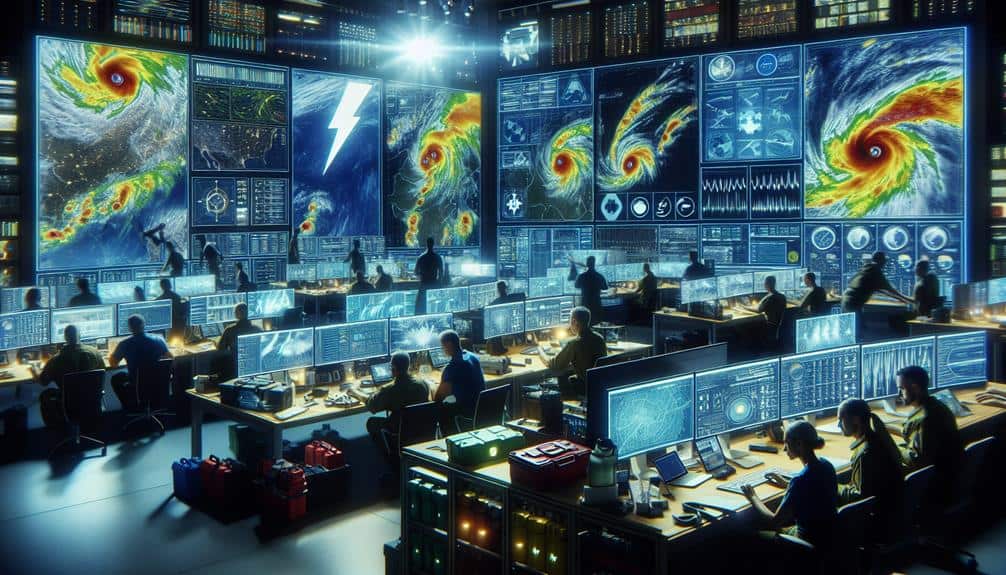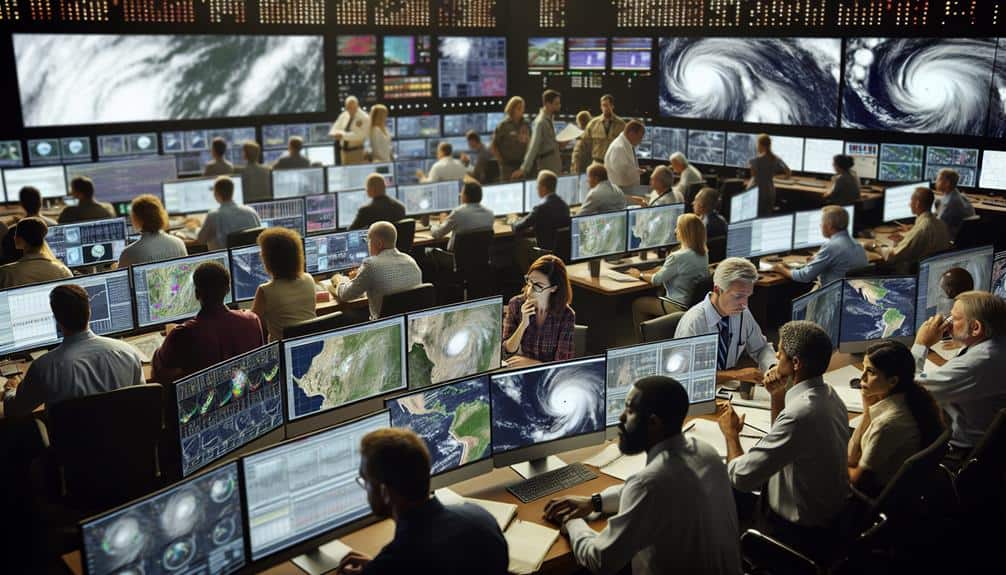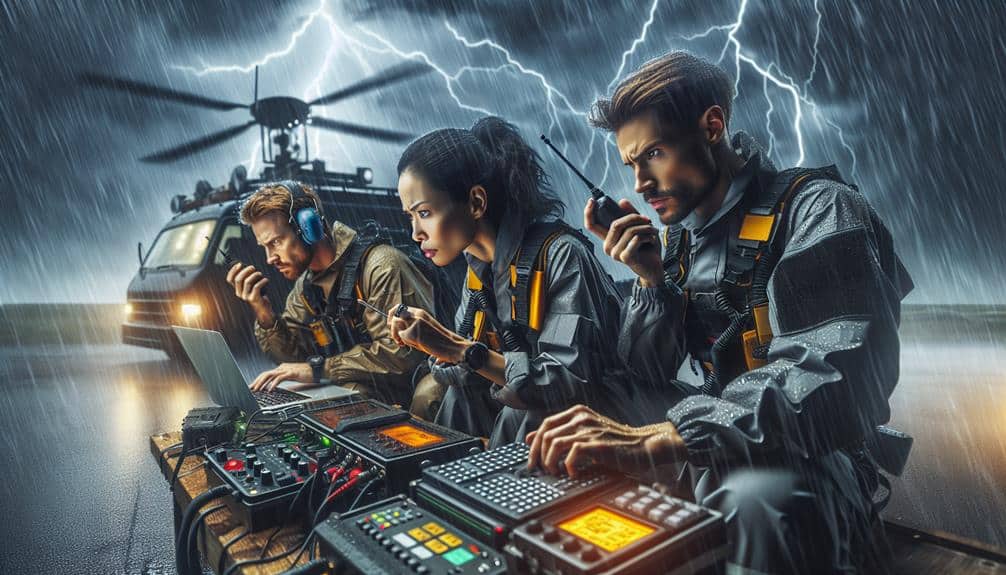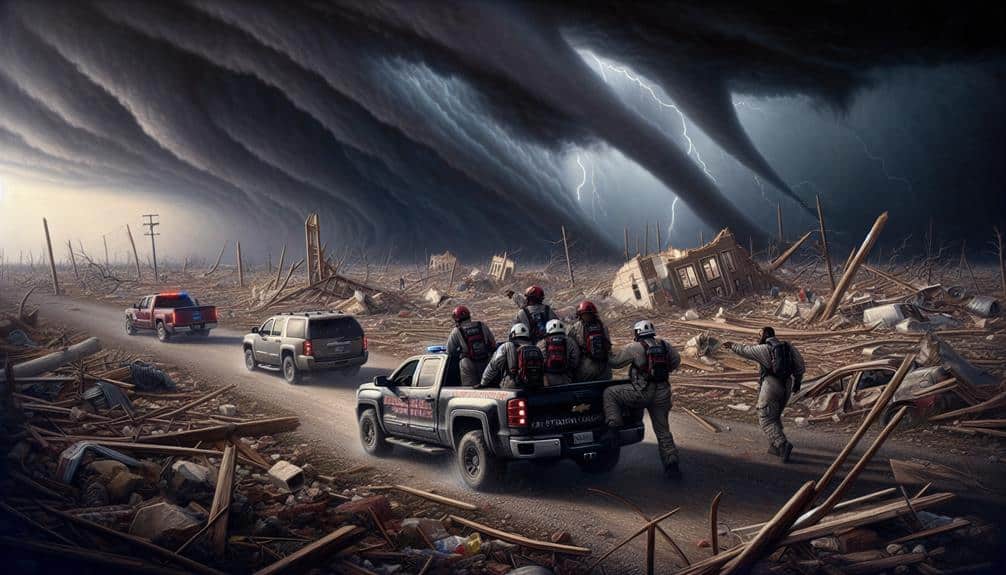We've improved our emergency response coordination strategies by utilizing real-time communication tools such as satellite phones and mobile apps, guaranteeing immediate emergency alerts and flexible planning. Our integration of radar systems, satellite imagery, and sensors offers detailed models for proactive risk reduction. Safety procedures concentrate on GPS tracking, precise evacuation plans, and thorough equipment upkeep. Thorough team training readies us for operational preparedness through simulated exercises and crisis management methods. Effective resource distribution and partnerships with authorities guarantee efficient operations and information exchange. Post-event analysis consistently enhances our procedures. Explore further to reveal deeper insights into our structured approach.
Key Points
- Utilize real-time communication tools like satellite phones to instantly disseminate emergency alerts and coordinate response planning.
- Integrate weather data from radar systems and satellite imagery for high-resolution risk mitigation models.
- Implement strict safety protocols, including GPS tracking, clear evacuation procedures, and routine vehicle maintenance.
- Conduct thorough team training with simulated disaster drills and crisis management techniques.
Real-Time Communication Tools
Real-time communication tools are vital for coordinating storm chasers' emergency response efforts efficiently and effectively. Using robust platforms like satellite phones, radio systems, and mobile apps, we can synchronize our actions seamlessly. These tools enable us to disseminate emergency alerts instantly, making sure that every team member is informed about the latest developments and potential hazards. This heightened level of coordination is pivotal when executing response planning and implementation.
With real-time data transmission, we can adapt our strategies on the fly, enhancing our operational agility. For instance, when an emergency alert is received, our communication systems allow us to relay critical information to all units, optimizing resource allocation and minimizing response time. This real-time coordination ensures that our emergency response planning isn't only dynamic but also highly effective.
Moreover, the precision of these communication tools helps in the execution of complex maneuvers, such as deploying sensors or arranging evacuation routes. By maintaining constant communication, we can adjust to rapidly changing weather conditions and other unforeseen challenges.
Essentially, real-time communication tools empower us to make informed decisions quickly, guaranteeing our emergency response efforts are executed with maximum efficiency and effectiveness.
Weather Data Integration
Integrating weather data from multiple sources, including radar systems, satellite imagery, and ground-based sensors, allows us to enhance the accuracy and timeliness of our storm tracking and response operations. By leveraging the latest technological advancements, we can synthesize disparate data streams into cohesive, actionable insights. This integration is pivotal for making informed, real-time decisions that optimize our emergency response strategies.
Incorporating data analytics tools enables us to process vast amounts of meteorological data quickly and efficiently. Through advanced algorithms and machine learning models, we can identify storm patterns and predict their trajectories with greater precision. This not only improves our situational awareness but also empowers us to act swiftly, maximizing our operational effectiveness.
Moreover, the fusion of various weather data sources facilitates the creation of high-resolution models. These models can simulate potential storm impacts, allowing us to anticipate and mitigate risks proactively. As a result, our teams are better equipped to deploy resources strategically, ensuring that we maintain the freedom to operate safely and effectively in volatile conditions.
Safety Protocols
To safeguard the well-being of our team, we implement strict safety protocols that are continuously refined based on the latest data and field observations. Our primary focus is on emergency response and preemptive safety measures. We guarantee our vehicles are equipped with real-time GPS tracking and mobile weather stations to provide immediate access to atmospheric data. This allows us to make informed decisions quickly.
We always assign a safety officer responsible for monitoring weather conditions and communicating potential hazards. This role is crucial during high-risk operations, ensuring that everyone remains informed and can act swiftly. Our communication systems include satellite phones and two-way radios to maintain constant contact, even in remote areas.
In terms of emergency response, we've established a clear evacuation protocol. Should conditions exceed safe parameters, the safety officer initiates an immediate withdrawal to a pre-designated safe zone. Additionally, we carry thorough first-aid kits and train all members in basic medical response techniques.
Our safety measures also include routine vehicle maintenance checks and confirming that personal protective equipment (PPE) is up-to-date and worn at all times. By adhering to these strict safety protocols, we maximize our operational efficacy while safeguarding our team's freedom to explore and document severe weather phenomena.
Team Training Programs
We prioritize thorough team training programs to guarantee operational readiness.
Our focus areas include simulated disaster drills for realistic scenario practice, communication skills enhancement to optimize information flow, and equipment handling techniques to maximize efficiency.
These targeted training modules are essential for improving our response capabilities during storm events.
Simulated Disaster Drills
Simulated disaster drills provide our team with realistic, hands-on training to enhance coordination and response effectiveness during actual emergency situations. These drills are integral to our crisis management and emergency preparedness training programs. By replicating real-world scenarios, we can evaluate our response protocols, identify potential weaknesses, and refine our strategies. Each drill employs advanced simulation technology to mimic conditions such as severe weather patterns, infrastructure failures, and communication disruptions.
Our data-driven approach to these drills includes collecting and analyzing performance metrics. We track response times, decision-making efficiency, and team coordination. For example, during a recent tornado simulation, our team reduced response time by 15% compared to previous drills, highlighting the effectiveness of iterative training.
Moreover, we incorporate feedback loops post-drill to guarantee continuous improvement. After-action reviews (AARs) provide us with valuable insights into both individual and collective performance. By meticulously examining these data points, we can make precise adjustments to our crisis management strategies.
Freedom to act swiftly and decisively in emergency scenarios is paramount, and these simulated drills empower us to do just that. Through rigorous, data-backed training, we enhance our capabilities to protect communities and save lives.
Communication Skills Enhancement
Building on the insights gained from our simulated disaster drills, enhancing communication skills within our team training programs becomes imperative to improve operational effectiveness. Our focus is on developing robust crisis communication and honing interpersonal skills to ensure precise and efficient information exchange during emergencies.
We've identified several key areas to address in our training:
- Real-time Information Sharing: Utilizing advanced communication platforms to disseminate critical updates swiftly.
- Active Listening Techniques: Training our team to fully engage and understand each other's inputs, reducing misunderstandings.
- Stress Management: Equipping team members with strategies to maintain composure and clarity under pressure.
- Role-specific Communication Protocols: Customizing communication methods for different roles to streamline operations.
Data shows that effective crisis communication can reduce response times by up to 30%, significantly impacting our overall mission success. By fostering strong interpersonal skills, we empower each member to act decisively and collaboratively, ensuring that our coordinated efforts are both agile and resilient.
For an audience that values autonomy, these improvements afford us the freedom to navigate chaotic environments with confidence and competence. By investing in these critical areas, we're not just responding to storms—we're mastering the art of crisis management.
Equipment Handling Techniques
Effective equipment handling techniques are essential for our team to guarantee safety, efficiency, and reliability during emergency responses. Our training programs emphasize the critical importance of equipment maintenance to ensure operational readiness. By conducting regular inspections, calibrations, and functional tests, we verify that every device—from anemometers to portable weather radars—is in prime condition.
We implement rigorous handling techniques to mitigate risks associated with equipment failure. Our protocols mandate that all gear is stored in protective cases, transported securely, and handled with precision. During deployment, we adhere to standardized procedures to set up and operate equipment swiftly and accurately, minimizing downtime and maximizing data collection efficiency.
In emergency response scenarios, equipment readiness is non-negotiable. We train our team members to perform rapid assessments and immediate troubleshooting on-site, ensuring that any technical issues are swiftly addressed. This proactive approach reduces the likelihood of critical equipment malfunctions during high-stakes operations.
Our data-driven training modules incorporate scenario-based drills and real-time simulations. These exercises enhance our team's ability to adapt to unpredictable conditions while maintaining control over our tools. By mastering these equipment handling techniques, we empower ourselves to respond swiftly and effectively, safeguarding both our team and the communities we serve.
Resource Allocation

Let's optimize our resource allocation by focusing on:
- Equipment deployment efficiency
- Personnel assignment protocols
We need to guarantee:
- Rapid mobilization of assets
- Precise matching of skill sets to tasks
Equipment Deployment Efficiency
Optimizing equipment deployment efficiency hinges on a detailed analysis of resource allocation patterns and real-time data integration. We've learned that successful emergency response relies heavily on precise coordination techniques and well-maintained equipment. Making certain our equipment is in top condition is non-negotiable. Regular equipment maintenance mitigates the risk of malfunctions during critical moments, allowing us to deploy resources swiftly and effectively.
Our deployment strategies must be adaptive and data-driven, leveraging real-time information to allocate resources where they're needed most. This approach enables us to respond to dynamic storm conditions without unnecessary delays.
We prioritize the following to evoke efficient resource allocation:
- Immediate Access to Real-Time Data: Crucial for making prompt, informed decisions.
- Automated Systems: For quick, accurate resource tracking and allocation.
- Redundant Communication Channels: Ensures coordination doesn't falter under extreme conditions.
- Pre-positioned Equipment: Strategic placement reduces response times.
Personnel Assignment Protocols
Securing our personnel are correctly assigned pivots on a robust protocol that matches individual skill sets with specific operational needs, enhancing overall mission effectiveness. We utilize task delegation and team coordination to distribute responsibilities efficiently.
By conducting thorough assessments of each team member's expertise in areas such as meteorological analysis, data collection, and field operations, we can strategically assign roles that maximize productivity and safety.
Response prioritization is critical in fast-paced storm-chasing environments. We employ a dynamic response prioritization framework that ranks tasks based on urgency and the potential impact on mission success. This framework allows us to focus our efforts where they're most needed, ensuring critical actions are executed promptly.
A well-defined communication chain is indispensable for maintaining clarity and coordination. We implement a hierarchical communication structure that guarantees information flows seamlessly from field operatives to command centers. This structure minimizes miscommunication and enables real-time updates, allowing us to adapt swiftly to evolving situations.
Our personnel assignment protocols are designed to empower our team, giving each member the freedom to excel in their specific roles while maintaining a cohesive operational strategy. By leveraging these protocols, we enhance our capability to respond effectively to severe weather events.
Supply Chain Management
Effective supply chain management is vital for storm chasers, as it secures timely allocation of essential resources like fuel, equipment, and communication tools to sustain operations during severe weather events. We need to focus on precise inventory tracking and distribution management to ascertain that every asset is accounted for and deployed efficiently. By implementing robust risk assessment and emergency preparedness protocols, we can mitigate disruptions and maintain operational fluidity.
In the heat of a storm, our ability to adapt and allocate resources quickly can mean the difference between success and failure. Leveraging advanced inventory tracking technologies enables real-time monitoring of our supplies, ensuring nothing falls through the cracks. Distribution management systems streamline the process, reducing delays and maximizing resource utilization.
These challenges underscore the critical importance of our supply chain strategy. By prioritizing emergency preparedness and conducting thorough risk assessments, we secure that our team remains agile and resilient amidst adversity. Our freedom to chase storms safely hinges on our meticulous resource allocation and unwavering commitment to operational excellence.
- Fuel shortages impeding mobility
- Equipment failure jeopardizing lives
- Communication breakdowns isolating team members
- Delayed medical supplies imperiling health
Collaboration With Authorities
Collaboration with authorities is essential for storm chasers to synchronize real-time data sharing and enhance emergency response efforts. By establishing robust community partnerships, we can guarantee that our data contributes meaningfully to disaster response operations.
Working closely with local law enforcement, emergency medical services, and the National Weather Service allows us to integrate our on-the-ground observations with broader emergency management protocols. This collaboration not only improves public safety but also optimizes resource allocation during critical moments.
Our primary focus is on leveraging advanced meteorological instruments and communication tools to relay accurate, real-time information to authorities. We use GPS-enabled tracking systems and satellite communication to provide precise location data, which is invaluable during search and rescue missions.
These efforts are bolstered through pre-established Memorandums of Understanding (MOUs) with local and state agencies, guaranteeing a seamless flow of information.
Post-Event Analysis

After working with authorities during the storm, we conduct a thorough post-event examination to evaluate our response effectiveness and refine future strategies. This process involves scrutinizing data collected during the event to identify lessons learned and improvement opportunities. By meticulously examining our methodologies, we secure continuous advancement in storm response coordination.
We start by reviewing communication logs, GPS tracking data, and meteorological reports to identify patterns and areas requiring enhancement. This empirical approach enables us to pinpoint bottlenecks and inefficiencies that could be addressed in subsequent operations.
Key elements of our post-event examination include:
- Data Integrity: Securing all data captured during the storm is accurate and usable for future modeling.
- Response Time Analysis: Evaluating how quickly and efficiently we could mobilize and respond to real-time storm developments.
- Resource Allocation: Appraising the adequacy of equipment and personnel deployed in various scenarios.
- Stakeholder Feedback: Gathering insights from local authorities, emergency services, and affected communities.
Frequently Asked Questions
How Do Storm Chasers Maintain Their Vehicles for Extreme Weather Conditions?
We guarantee vehicle maintenance by regularly inspecting and servicing engines, brakes, and tires. For weatherproofing gear, we install reinforced windows, durable body coatings, and waterproof seals, guaranteeing our vehicles withstand extreme weather conditions and keep us operational.
What Personal Protective Equipment Is Essential for Storm Chasers?
We can't overstate the importance of safety gear for storm chasers. Essential items include helmets, weather-resistant clothing, and weather monitoring devices. These tools guarantee we stay safe and informed while maneuvering through extreme conditions, preserving our freedom to chase.
How Do Storm Chasers Balance Their Passion With the Risks Involved?
We balance our passion with the inherent risks by conducting thorough risk assessments and implementing stringent safety measures. Additionally, we prioritize our mental health by employing effective coping strategies to handle the stress and maintain focus during storms.
What Are the Psychological Impacts of Storm Chasing on Individuals?
The psychological impacts of storm chasing can be profound. Our mental health often dances on a tightrope, requiring robust coping mechanisms. Data indicates increased stress levels, but the freedom we chase makes the risk worthwhile.
How Do Storm Chasers Secure Funding for Their Expeditions?
We obtain funding through sponsorship opportunities and grant applications. Our fundraising events and donor partnerships also play critical roles. These methods guarantee resource allocation, maximizing our operational effectiveness and maintaining our commitment to freedom in storm chasing.


